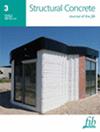含纳米氧化铝颗粒和微型钢纤维的土工聚合物复合材料的力学、微观结构和热学特性分析
IF 3
3区 工程技术
Q2 CONSTRUCTION & BUILDING TECHNOLOGY
引用次数: 0
摘要
水泥生产排放的二氧化碳占全球总排放量的 5%-7%,因此需要土工聚合物复合材料(GCOMP)等可持续替代品来满足日益增长的混凝土需求。本研究通过加入纳米氧化铝(n-alumina)和 MSF(MSF),对 GCOMP 的机械、微观结构和热性能进行了研究。纳米氧化铝的含量按重量计分别为 1%、2% 和 3%,而 MSF 的含量则固定为 0.5%。热表征温度高达 800°C。将含有正氧化铝的 GCOMP 混合物的性能与仅含 0.5% MSF 的对照混合物进行了比较。对所有 GCOMP 混合物的各种机械性能进行了评估。使用扫描电子显微镜(SEM)、X 射线衍射(XRD)和傅立叶变换红外光谱(FTIR)分析了微观结构和矿物学特征。对 GCOMP 混合料的热分析采用了高达 800°C 的热重分析和差热分析。结果表明,2% 的正氧化铝可达到最佳机械性能(抗压强度和抗折强度分别提高了 35.65% 和 77.7%)。此外,氧化铝的加入还改善了界面区,使结构更加致密。GCOMP 灰泥在 25°C 至 250°C 之间会出现质量损失,在 250°C 至 715°C 之间质量损失很小。在 715°C 至 800°C 之间没有观察到质量损失。MSF 加固的 GCOMP 灰泥的最终质量损失约为 12%,MSF 的影响可忽略不计。在 MSF 增强型 GCOMP 中加入正氧化铝颗粒后,样品强度更高,其特征是含有 C-S-H、氧化铝氢氧化钙和石英。本文章由计算机程序翻译,如有差异,请以英文原文为准。
Mechanical, microstructural, and thermal characterization of geopolymer composites with nano‐alumina particles and micro steel fibers
Cement production is responsible for 5%–7% of global CO2 emissions, highlighting the need for sustainable alternatives like geopolymer composite (GCOMP) to meet the growing demand for concrete. This study investigates the mechanical, microstructural, and thermal properties of GCOMP by incorporating nano‐alumina (n ‐alumina) and MSF (MSF). The n ‐alumina content was varied at 1%, 2%, and 3% by weight of the mix, while the MSF content remained fixed at 0.5% by weight. Thermal characterization was conducted up to 800°C. The performance of GCOMP blends with n ‐alumina was compared to a control blend consisting of only 0.5% MSF. Various mechanical properties were evaluated for all GCOMP blends. Microstructural and mineralogical characteristics were analyzed using scanning electron microscopy (SEM), X‐ray diffraction (XRD), and Fourier‐transform infrared spectroscopy (FTIR). Thermogravimetric and differential thermal analysis were performed up to 800°C for the thermal analysis of the GCOMP mix. The results indicate that the optimal mechanical properties were achieved with 2% n ‐alumina (compressive and flexural strength increased by 35.65% and 77.7%, respectively). Additionally, the incorporation of n ‐alumina improves the interfacial zones and results in a denser structure. GCOMP mortars portrayed a mass loss between 25°C and 250°C, with a marginal mass loss occurring between 250°C and 715°C. No mass loss was observed between 715°C and 800°C. The MSF‐reinforced GCOMP mortars experienced an ultimate mass loss of approximately 12%, with the MSF showing negligible influence. The addition of n ‐alumina particles to MSF‐reinforced GCOMP resulted in the development of stronger samples characterized by the presence of C–S–H, calcium aluminate oxide hydroxide, and quartz.
求助全文
通过发布文献求助,成功后即可免费获取论文全文。
去求助
来源期刊

Structural Concrete
CONSTRUCTION & BUILDING TECHNOLOGY-ENGINEERING, CIVIL
CiteScore
5.60
自引率
15.60%
发文量
284
审稿时长
3 months
期刊介绍:
Structural Concrete, the official journal of the fib, provides conceptual and procedural guidance in the field of concrete construction, and features peer-reviewed papers, keynote research and industry news covering all aspects of the design, construction, performance in service and demolition of concrete structures.
Main topics:
design, construction, performance in service, conservation (assessment, maintenance, strengthening) and demolition of concrete structures
research about the behaviour of concrete structures
development of design methods
fib Model Code
sustainability of concrete structures.
 求助内容:
求助内容: 应助结果提醒方式:
应助结果提醒方式:


